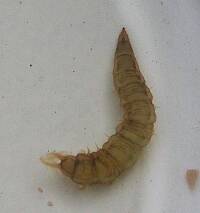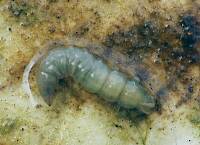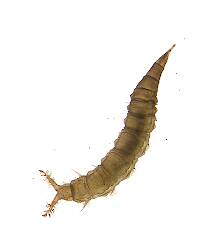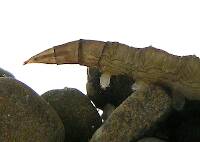
Hex Mayflies
Hexagenia limbata
The famous nocturnal Hex hatch of the Midwest (and a few other lucky locations) stirs to the surface mythically large brown trout that only touch streamers for the rest of the year.
Featured on the forum

Some characteristics from the microscope images for the tentative species id: The postero-lateral projections are found only on segment 9, not segment 8. Based on the key in Jacobus et al. (2014), it appears to key to Neoleptophlebia adoptiva or Neoleptophlebia heteronea, same as this specimen with pretty different abdominal markings. However, distinguishing between those calls for comparing the lengths of the second and third segment of the labial palp, and this one (like the other one) only seems to have two segments. So I'm stuck on them both. It's likely that the fact that they're immature nymphs stymies identification in some important way.

Troutnut is a project started in 2003 by salmonid ecologist Jason "Troutnut" Neuswanger to help anglers and
fly tyers unabashedly embrace the entomological side of the sport. Learn more about Troutnut or
support the project for an enhanced experience here.
Troutnut on Sep 12, 2007September 12th, 2007, 4:20 pm EDT
At least, Volume I: Mayflies. Volume II is in the mail.
My first impressions are mostly good. It's an unparalleled quantity of information. Most of the space seems to be filled with technical scientific species descriptions put to more readable prose, great fodder for us bug geeks, and that stuff is punctuated by the sort of history and anecdotes that make Schwiebert appeal to a wider audience. The first 96 pages of the book are several chapters comprising a complete history of nymphing on both sides of the Atlantic.
As for the bug stuff, no book targeting the angler has ever included nearly this much detail, so it's a worthy addition to any library. I am puzzled (rather than bothered) by the out-of-date taxonomy in many places. Schwiebert was clearly very interested in the scientific history of each species and he writes a lot about the scientists and papers involved in their discovery and early taxonomy. Yet he scarcely seems to recognize taxonomic changes within the last 20 years in the book. This doesn't have any relevant effect for the angler -- it just makes me curious, because Schwiebert clearly had a strong appetite for exactly the sort of details he omitted. Maybe he did much of the work on this new edition by hand and over a period of 30+ years and didn't have an efficient way to update such a huge volume when changes came around.
Also, congratulations to Roger Rohrbeck (Taxon here) for his mention in the Acknowledgments on page (xiii) of the book. Erik Schwiebert (Ernest's son) gives Roger particular thanks for helping check the entomology.
I'm looking forward to getting time to read this book and I'll post a more thorough review when I do, but that might be a while. Grad school has left me with much less time for recreational reading, especially of such long books.
My first impressions are mostly good. It's an unparalleled quantity of information. Most of the space seems to be filled with technical scientific species descriptions put to more readable prose, great fodder for us bug geeks, and that stuff is punctuated by the sort of history and anecdotes that make Schwiebert appeal to a wider audience. The first 96 pages of the book are several chapters comprising a complete history of nymphing on both sides of the Atlantic.
As for the bug stuff, no book targeting the angler has ever included nearly this much detail, so it's a worthy addition to any library. I am puzzled (rather than bothered) by the out-of-date taxonomy in many places. Schwiebert was clearly very interested in the scientific history of each species and he writes a lot about the scientists and papers involved in their discovery and early taxonomy. Yet he scarcely seems to recognize taxonomic changes within the last 20 years in the book. This doesn't have any relevant effect for the angler -- it just makes me curious, because Schwiebert clearly had a strong appetite for exactly the sort of details he omitted. Maybe he did much of the work on this new edition by hand and over a period of 30+ years and didn't have an efficient way to update such a huge volume when changes came around.
Also, congratulations to Roger Rohrbeck (Taxon here) for his mention in the Acknowledgments on page (xiii) of the book. Erik Schwiebert (Ernest's son) gives Roger particular thanks for helping check the entomology.
I'm looking forward to getting time to read this book and I'll post a more thorough review when I do, but that might be a while. Grad school has left me with much less time for recreational reading, especially of such long books.
Jason Neuswanger, Ph.D.
Troutnut and salmonid ecologist
Troutnut and salmonid ecologist
Taxon on Sep 12, 2007September 12th, 2007, 7:27 pm EDT
Jason-
Ernest Schwiebert disagreed rather passionately with some revisions in mayfly taxonomic placement. This seems to have boiled over on page 425, where he briefly discusses his view of the re-organization of Stenonema. Also, even though "Ernie" was aware of the elevation of various Ephemerella subgenera to genus status, he seems to have been enamored with their prior placement. And, there are several other instances where he apparently held strongly opposing taxonomic views.
So, even though I was able to provide up-to-date taxonomy for nearly all of the (991) scientific names the publisher had parsed from Erne's original manuscript, out of respect for his father's strongly held views, Erik chose not to use some of them. And, he used others of them somewhat inconsistently, which was likely due to the sheer volume of instances of use in the text and index in combination with being held to an incredibly tight deadline by the publisher.
Having said that, Ernest Schwiebert created an incredible resource by rewriting Nymphs, and Erik Schwiebert performed a real “act of love” for his father by undertaking the extremely difficult job of making sure the manuscript got published. I am in awe of both of their efforts.
Ernest Schwiebert disagreed rather passionately with some revisions in mayfly taxonomic placement. This seems to have boiled over on page 425, where he briefly discusses his view of the re-organization of Stenonema. Also, even though "Ernie" was aware of the elevation of various Ephemerella subgenera to genus status, he seems to have been enamored with their prior placement. And, there are several other instances where he apparently held strongly opposing taxonomic views.
So, even though I was able to provide up-to-date taxonomy for nearly all of the (991) scientific names the publisher had parsed from Erne's original manuscript, out of respect for his father's strongly held views, Erik chose not to use some of them. And, he used others of them somewhat inconsistently, which was likely due to the sheer volume of instances of use in the text and index in combination with being held to an incredibly tight deadline by the publisher.
Having said that, Ernest Schwiebert created an incredible resource by rewriting Nymphs, and Erik Schwiebert performed a real “act of love” for his father by undertaking the extremely difficult job of making sure the manuscript got published. I am in awe of both of their efforts.
Troutnut on Sep 12, 2007September 12th, 2007, 8:05 pm EDT
Thanks for the explanation. You're right that it is outstanding regardless of the taxonomic oddities.
I can see how he might oppose some of the reorganization that occurred, but it seems strange that the Ephemerellidae were on that list. If ever there were a genus in need of a split, the old Ephemerella was it. I'm sure he had very interesting reasons -- what a shame he's not still around to address our little concentration of some of his biggest fans.
I can see how he might oppose some of the reorganization that occurred, but it seems strange that the Ephemerellidae were on that list. If ever there were a genus in need of a split, the old Ephemerella was it. I'm sure he had very interesting reasons -- what a shame he's not still around to address our little concentration of some of his biggest fans.
Jason Neuswanger, Ph.D.
Troutnut and salmonid ecologist
Troutnut and salmonid ecologist
Taxon on Sep 12, 2007September 12th, 2007, 8:50 pm EDT
I'm sure he had very interesting reasons -- what a shame he's not still around to address our little concentration of some of his biggest fans.
That's for sure. But at least, he may be able to sense our collective admiration.
Gene
Posts: 107
Posts: 107
Gene on Sep 13, 2007September 13th, 2007, 7:13 am EDT
Gentlemen:
Schwiebert and I touched upon in conversations the reclassification scheme as proposed my McCafferty and others and he was a bit amused but not impressed scientifically (even in 1991 at the Entomological Convention in Baltimore Schwiebert expressed surprise at what was going on in the classification system over a few beers one evening and just sort of shook his head). I don't know if he had time to change much of this due to his illness in the last couple of years of his life. He also thought that many of his drawings and descriptions of his nymphs were purloined to say the least by some in the scientific field. I leave that at that if you know what I mean.
I miss Ernie. I talked to him about month and half before his untimely death. He was one of the few in the fly fishing arena who had the balls to come to my defense when I got sued by Robert kennedy Jr. and his juggernaut Riverkeeper Inc. over the word riverkeeper. He was ready to testify or undergo deposition. He was a great mind and a great fly fisherman. His talk at Fly Fisher's Club of Harrisburg a few years ago was one of the most endearing performances I have ever seen in fly fishing.
One should look at his new Nymphs editions as a retrospect and encompassing of fly fishing and not a manual on classification. I have a nice memorial piece on him at www.flyfisher.com for anyone who is interested. I know this the late Charlie Fox absolutely adored him...that has to say something about the man!
gene
www.flyfisher.com
there are nymphs and there are nymphs. But all nymphs are young and beautiful.....right!
Schwiebert and I touched upon in conversations the reclassification scheme as proposed my McCafferty and others and he was a bit amused but not impressed scientifically (even in 1991 at the Entomological Convention in Baltimore Schwiebert expressed surprise at what was going on in the classification system over a few beers one evening and just sort of shook his head). I don't know if he had time to change much of this due to his illness in the last couple of years of his life. He also thought that many of his drawings and descriptions of his nymphs were purloined to say the least by some in the scientific field. I leave that at that if you know what I mean.
I miss Ernie. I talked to him about month and half before his untimely death. He was one of the few in the fly fishing arena who had the balls to come to my defense when I got sued by Robert kennedy Jr. and his juggernaut Riverkeeper Inc. over the word riverkeeper. He was ready to testify or undergo deposition. He was a great mind and a great fly fisherman. His talk at Fly Fisher's Club of Harrisburg a few years ago was one of the most endearing performances I have ever seen in fly fishing.
One should look at his new Nymphs editions as a retrospect and encompassing of fly fishing and not a manual on classification. I have a nice memorial piece on him at www.flyfisher.com for anyone who is interested. I know this the late Charlie Fox absolutely adored him...that has to say something about the man!
gene
www.flyfisher.com
there are nymphs and there are nymphs. But all nymphs are young and beautiful.....right!
Quick Reply
Related Discussions
Topic
Replies
Last Reply
Re: Amazon.com ship dates for new edition of Ernest Schwiebert's Nymphs
In General Discussion by Troutnut
In General Discussion by Troutnut
2
Jun 15, 2007
by Taxon
by Taxon
Re: Helopicus subvarians (Stonefly) common in New York waters!
In the Stonefly Genus Helopicus by Walleye
In the Stonefly Genus Helopicus by Walleye
6
Jan 9, 2014
by Entoman
by Entoman
10
Mar 29, 2007
by Shawnny3
by Shawnny3








